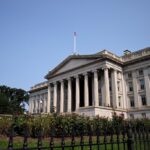India plans to reduce its tariff differential between the US and India by almost 9 percentage points, bringing it from 13% down to just under 4%. This is an important step towards securing exemptions to President Donald Trump’s tariff increases.
New Delhi has taken one of its most ambitious trade liberalisation initiatives to date with this sweeping proposal.
The announcement comes at a time when the two nations are intensifying efforts to reach a finalised bilateral trade deal that could redefine economic relations between the largest and fifth biggest economies in the world.
In 2024, bilateral trade between the US and India will reach $129 billion. India has a surplus of $45.7 billion in this relationship.
New Delhi, which is anxious to get a deal done before other countries such as Japan, has been racing to catch up with Trump, who recently concluded a trade agreement with the UK.
US wants deeper access
India offered preferential trade access for nearly 90% of US exports, and plans were made to reduce tariffs to zero in 60% of tariff categories during the first phase.
The offer’s structure is intended to mimic the UK-US recent deal which reduced average British tariffs for American goods, but maintained Washington’s base 10% tariff.
India, for its part, wants to protect its exports–gems, jewellery, clothing, textiles (including apparel), chemicals, oilseeds and shrimp–by obtaining preferential access to the US market.
Officials familiar with negotiations claim that India also seeks special concessions in order to compete against rival suppliers.
India is under pressure to negotiate favorable terms with the US while also avoiding protectionist policies. The current trade surplus between the US and India stands at 45.7 billion dollars.
The 10% tariff on Indian products remains during the 90 day pause announced by Trump in December, when he temporarily stopped a 26% proposed tariff.
India wants to be a tech powerhouse
India, beyond the reduction in tariffs, is also aiming to gain strategic recognition within Washington’s high tech ecosystem.
Indian negotiators have requested that as part of discussions the US treats India the same way it does its allies, such as Britain and Australia.
The US government may not be receptive to this request, as they often have stricter rules on technology sharing due to export controls and national security frameworks.
The push is a reflection of India’s desire to be a technology leader at a moment when Western democracies want to divert away from Chinese suppliers.
India Offers Incentives
India’s offer to relax export restrictions on high-value American goods is meant to strengthen the country’s pitch.
These include airplanes and parts, electrical vehicles, medical equipment, luxury cars and wines, prunes and hydrocarbons.
India has made an offer that shows its willingness to open up areas of the country it had previously kept closed. This is done to make the deal more attractive for the Trump Administration.
India expects to be exempted from all tariffs for its exports. This expectation is in contrast with the UK agreement, which saw the US retain base tariffs after making concessions.
The final talks are underway
Indian officials want to close the agreement quickly, as Japan is also rushing to complete a similar trade deal.
The US Trade Minister Piyush Ghoyal is likely to join a delegation that will travel there later in the month, but his plans have not yet been confirmed.
The Indian trade ministry did not comment publicly about the current talks.
The four officials who spoke on this subject requested anonymity because the negotiation was so sensitive.
If the deal is secured, it could redefine not only India-US commerce but New Delhi’s place in an ever-changing global supply chain.
The post India Offers 9% Tariff Cut to Fast-Track $129 Billion US Trade Deal may be updated as new developments unfold.
This site is for entertainment only. Click here to read more




